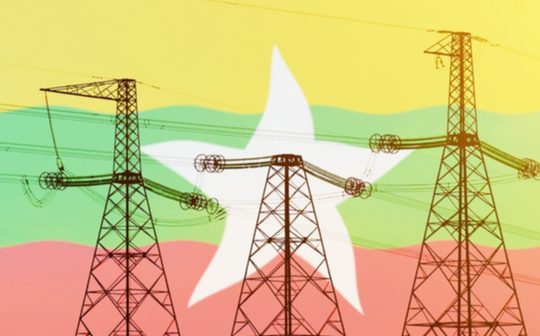
The Myanmar Government says it will accelerate the development of hydrocarbon and renewable energy even as it repairs power lines damaged by terrorists while seeking to increase foreign investments despite the threat of fresh economic sanctions, the Ministry of Information (MOI) and Ministry of Investment and Foreign Economic Relations (MIFER) announced today.
MOI Minister Mr Maung Maung Ohn and MIFER Minister Mr Aung Naing Oo issued the joint statement in response to recent media reports about energy shortages in the country and exits of some foreign energy companies, and fresh sanctions against Myanmar announced in recent months.
ADDRESSING ENERGY SHORTAGES IN MYANMAR
The recent temporary shortage of power was caused by a surge of global liquefied natural gas (LNG) prices, exacerbated by the Russia-Ukraine conflict, a weaker kyat currency as well as terrorist actions linked to the People’s Defensive Force (PDF). Apart from advocating a boycott of utility payments since 2021, PDF terrorists blew up power lines from the Lawpita hydroelectric plant in Kayah State. These actions contributed to outages which caused hardship to ordinary citizens and small businesses in particular.
However, despite earlier civil unrest, the country has largely achieved national stability since the second half of 2021. Myanmar Government, under the direction of the State Administration Council (SAC) that was formed on 2 February 2021, is focusing efforts on various mitigating actions regarding the country’s energy situation:
i) With the relative stabilization of global energy prices, the Government is seeking to increase use of natural gas for local power generation.
ii) The Government will step up repair of power infrastructure damaged by terrorists and increase security measures.
iii) It will accelerate power generation in the country from oil and gas sources through new investments, partnerships and actions such as conversion to use of existing facilities:
– the new Shwe Gas Pipeline was completed on 18 March 2022 and will generate about 330 MW of regular power.
– Conversion of some fertilizer plants (which use gas as feedstock) for immediate generation of 30 MW of electricity and accelerating works on other gas-fired power generators or waste-heat projects. A total of about 100 MW of electricity has been generated in Kyaukphyu using 20 million cubic feet of gas currently. After pipeline maintenance, this will expand to 30 million cubic feet per day and generate 195 MW.
iv) Major energy projects with China
As its largest neighbour and economic partner, China will play an increasingly important role in energy-related developments in Myanmar.
– With regard to the China-Myanmar pipeline project involving China National Petroleum Corporation (CNPC), the gas pipeline portion was completed at the end of 2013 and the oil pipeline portion was completed in April 2017. The project, which also includes a crude oil terminal, is CNPC’s largest investment in Myanmar, and a centerpiece of China’s Belt and Road Initiative in the country.
– Three Chinese companies – Union Resources and Engineering Company (41%), Yunnan Energy Investment (39%) and Zhefu Holding Group (1%) – are partnering Myanmar’s -Supreme Group (19%) to develop the 1,390MW Mee Lin Gyaing Project. This facility in Ayeyarwady region involves a LNG-fired power plant, a LNG terminal, a high voltage transmission line and gas pipelines to Yangon. It has been approved by the Myanmar Investment Commission. Currently in the early stages of design and construction, it is expected to start commercial operation in 2027.
Myanmar Government is also proposing to include this high-priority energy project – with an estimated investment value of USD 2.5 billion – in the list of early harvest projects of the China-Myanmar Economic Corridor (CMEC) to enhance bilateral cooperation so as to accelerate its progress.
v) Increase investments in renewable energy
– Solar Energy: More than half of the 40-MW Letpanhla and 30-MW Nyaungbin Gyi solar projects has been completed. To achieve national renewable energy goals, 13 solar power projects which will generate 370 MW have been launched.
While three more solar power projects which will generate 390-megawatt are also planned. Special efforts are being made to promote floating solar projects, rooftop solar projects, and small and medium-sized projects wherever possible.
Tenders are also being called for 18 solar power projects that can generate 635 MW. These are in addition to ongoing negotiations for 11 solar projects which will generate 300 MW that have been invited. Negotiations are underway to sign an agreement for one of them.
– Hydroelectric Power – With more than 60 hydropower dams, hydroelectricity is a key source of energy in the country. The Government is negotiating to purchase about 120 MW of electricity from the Tapin (1) hydropower project soon. The Government will emphasise proper environmental and social impact assessments before approval. Project designs must address such impact and communicate plans and benefits to the relevant communities in order to allay future concerns.
Myanmar plans to achieve national electrification by 2030 and generate 9% of electricity from renewable sources such as hydro and solar power.
REPORTED EXITS OF FOREIGN OIL AND GAS COMPANIES
The Ministers said the withdrawal by France’s TotalEnergies from the Yadana field and a related gas transportation project will be effective on 20 July 2022. The former’s 31.24% stake has been allocated proportionately to the remaining partners in the joint venture.
After the withdrawal of TotalEnergies, Thailand’s PTTEP International Limited (PTTEPI) will hold 37.0842% participating interest while Unocal Myanmar Offshore Company Limited, a subsidiary of Chevron Corporation (Chevron) of the United States, will hold 41.1016%, the highest participating interest in the project. Since the first shipment in 1996 about 70% of production from this project, or about 768 million standard cubic feet per day currently, has been sold to Thailand with the rest designated for domestic power generation.
“As this is a change of ownership, operations are not affected. The Yadana field has the largest known Myanmar offshore hydrocarbon reserves. However, production there has declined since end-2021 following 20 years of post-plateau output. Production at this field to date has reached 85% of the recoverable reserves,” the Ministers said. Total Energies is not seeking compensation for the withdrawal.
The Ministers said that while Chevron had stated it would exit investments from Myanmar, the Government has to date not received any formal notification from the company.
A third foreign energy company, Woodside Petroleum Ltd of Australia, has recently withdrawn from A6 Natural Gas Project in Rakhine State. Its stake has been taken over by its project partner the MPRL E&P Group of Companies. Operations are also not affected.
MYANMAR’S ENERGY SECTOR REMAINS ATTRACTIVE
Despite being one of the world’s oldest oil producers (exports started in 1853), Myanmar’s upstream sector is still in its infancy due to sanctions, opaque regulatory policy and insufficient investment.
“Although, proven energy reserves are still relatively modest, unofficial estimates are extremely promising. Such fields with potential which are also in proximity to large demand centres in Thailand and China have attracted the interest of several major players. Hence, the Government continues to speed up its reform and has held a number of successful international bids for such hydrocarbon fields,” the Ministers said.
RESPONSE TO FRESH ECONOMIC SANCTIONS AGAINST MYANMAR
The Ministers said that external pressure and fresh economic sanctions by several Western countries in recent months may have raised concerns among some foreign investors.
“Economic sanctions may have more negative impact on private sectors than on the Government. Domestic and foreign businessmen and their enterprises, local workers, suppliers and consumers end up suffering the most.
Some sizeable projects that had been approved have commenced construction. Due to the economic sanctions, promoters of some of these projects are now facing obstacles in transferring foreign currency. This has affected progress of the projects.
Should these projects be terminated due to sanctions their investors must repay tax exemptions they enjoyed on top of project costs incurred. Otherwise, their investments will remain in the pending state. Hence, investors may end up leaving Myanmar not because of an unfavourable investment environment but because of external pressures.
Myanmar is committed to providing a secure, accessible and conducive investment environment. We do not wish to see investment withdrawals.
Although the international community publicly discourages economic cooperation with Myanmar, we continue to attract foreign investments. Many of our foreign partners choose to work quietly with us, away from the glare of external publicity, fully recognizing Myanmar’s economic potential as well as its unique challenges,” the Ministers said.
ENERGY SECTOR REMAINS PRIORITY FOR TOTAL INVESTMENTS
The Ministers also gave an update on investments in Myanmar in the last 2 fiscal years. During fiscal 2020-2021 (12 months ended October) and fiscal 2021-2022 (interim budget of 6 months ended March) a total of 82 projects in 12 sectors with investments totaling USD 4.32 billion were approved (USD 3.79 billion in fiscal 2020-2021 and USD 530.775 million fiscal 2021-2022.)
Manufacturing accounted for most projects among 12 sectors in fiscal 2020-2021. However, the Power sector received substantially higher amount of total approved investment of USD 3.12 billion for 6 projects during this period, underscoring the attractiveness of the sector.
FOREIGN INVESTMENTS
Most of the countries investing in Myanmar are Singapore, China, Hong Kong, Thailand and South Korea. In fiscal year 2020-2021, a total of 15 projects were from China, and 14 projects were from Singapore.
In 2021-2022 FY, there are 18 projects from China and 6 were from Hong Kong.
DOMESTIC INVESTMENTS
In the last 2 fiscal years, a total of 93 domestic investment projects (61 in fiscal 2020-2021 and 32 in fiscal 2021-2022) in 12 sectors valued at 2,248.7 billion kyat (1,171.8 billion kyat in fiscal 2020-2021 and 1,076.9 billion kyat in fiscal 2021-2022, respectively) were approved.
A total of 50 projects were from the Manufacturing sector, which is the leading domestic investment category, followed by the Services sector which recorded 14 approved projects while Hotel and Tourism sector was third with 11 projects.





